Garmin's Vivosmart HR+ is still a fantastic fitness band
The Garmin Vivosmart HR+ is a feature-rich fitness band that sports GPS tracking, a built-in heart monitor and more. After using the Vivosmart HR+ for the past six months, it has proven to be a solid replacement for the Microsoft Band.

We first decided to check out the Vivosmart HR+ just over six months ago, after Microsoft discontinued its popular Band series of smart bands.
Today, after having used the Vivosmart HR+ for an extended period, we wanted to revisit the fitness band to see how well it held up to daily use and if our initial impressions held true. While the Garmin fell short in some areas, it proved to be a worthy replacement for the Microsoft Band over time.
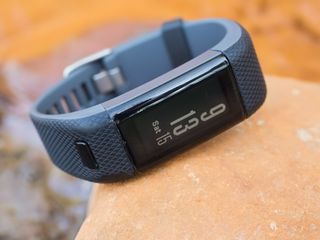
While many have turned to Fitbit to fill the void caused by the loss of the Microsoft Band, Garmin is another viable option. The Vivosmart HR+ is the closest offering from Garmin to the Microsoft Band and is slightly narrower and thicker than the Band 2. But at 1.1 ounces, Vivosmart HR+ is the lighter of the two.
The Vivosmart HR+ sports a 1-inch by 0.42-inch (160 x 68 pixel) touchscreen that is constantly on. The screen is backlit and extremely readable both indoors and outdoors. Navigation on the Vivosmart HR+ is accomplished by a series of swipes, taps, and a multi-function button that rests just below the screen.
This fitness band tracks steps, calories burned, distance walked, heart rate, floors climbed and intensity minutes. Additionally, screens are available for phone notifications, music controls, weather information and VIRB remote controls. Each display option, except for steps and the time and date, can be hidden on the Vivosmart HR+ through the Garmin Connect Mobile app.
The strap for the Vivosmart HR+ has a watch-style clasp and is very comfortable to wear. Combining the flexibility of the rubber strap and its light weight, it is easy to forget you are wearing the Vivosmart HR+.
Get the Windows Central Newsletter
All the latest news, reviews, and guides for Windows and Xbox diehards.

I wear my watch with the face of the device on the inside of my wrist. Some might call it backward, but it has always been the more comfortable way of wearing a watch for me. I use a screen protector on the Vivosmart HR+ and after six months, the only noticeable wear on the device is on the edges of the strap where it meets the actual device. Otherwise, the build quality of the Vivosmart HR+ has held up nicely over the past few months.
Daily wear
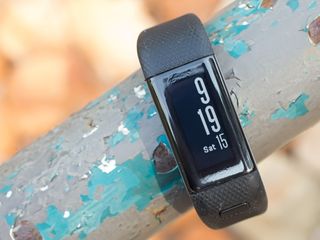
In general, I use the Garmin Vivosmart HR+ to track my steps, monitor my heart rate and track my fitness activities. I don't run much these days, due to my bad knees, and most of my fitness activity is restricted to the treadmill or a kayak. After a few visits with the doctor when I turned 50 a few years ago, I try to be active every day in some way. A fitness band helps me track my activity and visualize successes and failures.
Asides from the cosmetic wear on the strap, the only issue I have experienced with respect to fitness tracking is that occasionally the Vivosmart HR+ takes a considerable amount of time to acquire a GPS signal. This delay does not occur often enough to be a deal breaker and when the GPS signal is locked, the device charts your activities accurately. It is a great feature to have for runs, hikes or any other outdoor activity you want to map.
Otherwise, the Vivosmart HR+ performs admirably. The device is very responsive to taps and swipes, and the multi-function button remains as crisp. Battery life with the Vivosmart HR+ lasts about five days without using the GPS. On occasions when I used the GPS, battery life was cut down to about two days.
Software
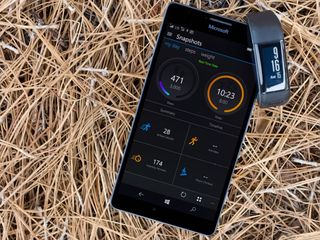
Garmin's companion app, Garmin Connect Mobile, is available for Windows 10 PC and Mobile. The free app compiles all the data the Vivosmart HR+ captures and offers several options to visualize your performance.
From the "snapshots" that display the bare bone stats on your daily activities to charting your heart rate, Garmin Connect Mobile likely has more features that many of us will ever use. You can customize what is displayed, how it is displayed and modify what the device's screen shows as well. If you only want the Vivosmart HR+ to track your distance, calories and heartrate during a run you can do that. There's no need to chart steps taken, you can turn that feature off. I probably use 50 percent to 60 percent of the Vivosmart HR+'s features, and it is nice to be able to filter out the ones I do not use.
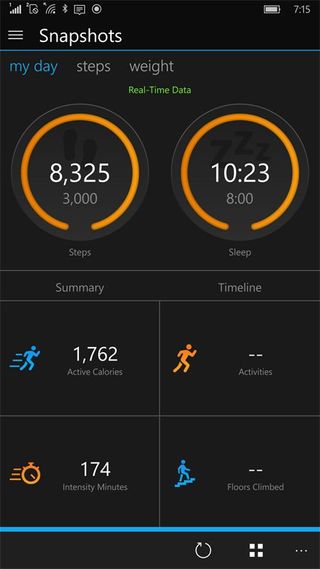
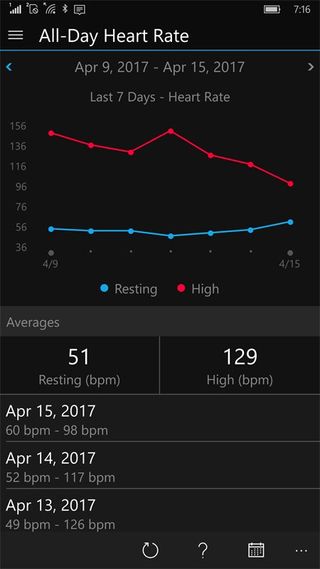

Garmin's software supports notifications, and you can customize the types of notifications you want to receive on the Vivosmart HR+ using the Garmin Connect Mobile app. Alert support is present, but do not expect this feature to perform with any consistency or reliability. The notification support is done through Bluetooth, and I am frankly shocked whenever this feature works. I can be sitting right next to my Lumia 950 XL and have incoming call notifications turned on with the Vivosmart HR+, only to have the fitness band remain silent when a call is received. I miss the reliability of the Microsoft Band's notifications and hopefully with all the work that is being done with GATT tech, Garmin and Fitbit will enjoy reliable notifications soon.
While I have learned to live without notifications on my fitness band, I have to give Garmin credit for the Garmin Connect Mobile app for Windows. It has been updated several times during the past six months and while I would like a light-colored theme, it turns out to be a solid, feature rich, companion app for the Vivosmart HR+.
Vivosmart HR+ is still a fantastic fitness band
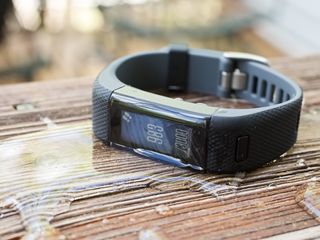
When Microsoft killed off Band, it boiled down to either the Fitbit Charge 2 or the Garmin Vivosmart HR+ to be my replacement. Appearance wise, Fitbit offers a cleaner looking, eye-appealing device. The Garmin is more rugged and no-nonsense in style, much like an old pair of sneakers.
Both the Fitbit and Garmin fitness systems do a great job of tracking your activities. There are a few design differences with the two systems, but neither are duds and the choice often boils down to personal needs. For me, it was the water resistance the Garmin was rated at. The Fitbit Charge 2 is sweat- and splash-proof but not rated for swimming or submersion. I sweat when I work out and spend a good bit of time out on the lake. I also don't like to take off my band when I do the dishes, water the lawn, wash my hands or any other activity that might get the device wet. Had the Fitbit Charge 2 been swim-friendly, I may have gone in that direction.
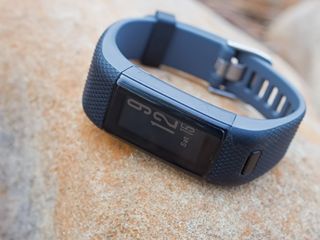
Even though I think Microsoft shot itself in the foot by discontinuing the Microsoft Band, as far as the Garmin Vivosmart HR+ is concerned, I feel as though I made the right choice. During the past six months, the device has held up nicely to my level of fitness activity and, with a few exceptions, performs admirably.
The Vivosmart HR+ currently costs $169.99 and is available in three colors and two sizes.
George is the Reviews Editor at Windows Central, concentrating on Windows 10 PC and Mobile apps. He's been a supporter of the platform since the days of Windows CE and uses his current Windows 10 Mobile phone daily to keep up with life and enjoy a game during down time.

